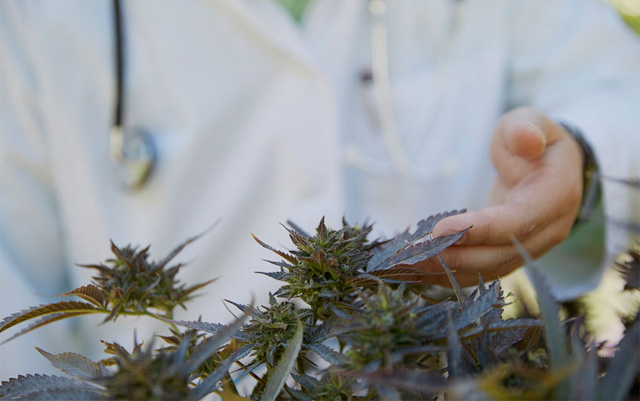In this stage of research and development (R&D), studying cannabis is most difficult because Big Pharma isn’t funding any of the research and scientists are facing barriers for federal approval of their studies.
Dr. Jacob Vigil, a researcher at the University of New Mexico, outlined the seemingly insurmountable federal barriers for studying the plant in the academic publication, American Association for the Advancement of Science’s (AAAS) Science Journal. In his academic paper, the professor outlines the extreme lengths and arduous paperwork researchers must overcome to get permission from multiple government agencies to study cannabis; some of which are fundamentally opposed to acceptance of any medical use for cannabis while it remains a Schedule I drug under the Controlled Substances Act.
“This has created a truly unique and an unnecessary paradox in modern medicine, in which physicians are authorizing treatments to patients, and patients are regularly using medication without a scientific basis of knowledge on patient outcomes, forced rather to rely only on scientifically invalid or anecdotal information,” Vigil wrote.

Related Article: Crowdfunding Medical Marijuana Research
The federal government did budge a bit in their anti-cannabis stance with the Drug Enforcement Agency (DEA) decision to pave a narrow path for the cultivation of more medical grade cannabis as well as encouraged studying of the medicinal effects of cannabidiol (CBD). At the same time, they also announced the denial of rescheduling the plant from its untouchable status as a Schedule 1 drug within the Controlled Substances Act. Interesting to note is the mention that even if they did reschedule, it would be to a Schedule 2, not 3 – due to an international drug control treaty that wouldn’t allow for it.
In short, Schedule 2 status allows medical research on a drug despite it having a high potential for abuse, like Oxycodone and Adderall. Schedule 3 status would allow research as well, and make cannabis akin to steroids and other drugs with a lower risk of abuse. The cannabis industry’s interests are best served if they can keep the plant out of the FDA/Big Pharma machine. That’s why groups like the National Cannabis Industry Association (NCIA) and National Organization for the Reform of Marijuana Laws (NORML) advocate for Schedule 3 or descheduling cannabis.
Paul Armentano, NORML Deputy Director, blogged about why descheduling cannabis is the best option.
“But ultimately, such a change would do little to significantly loosen federal prohibition or to make herbal cannabis readily accessible for clinical study. These goals can arguably only be accomplished by federally descheduling cannabis in a manner similar to alcohol and tobacco, such as is proposed by US Senate Bill 2237, The Ending Federal Marijuana Prohibition Act. Doing so will finally provide states the power to establish their own marijuana policies free from federal intrusion.”

Related Article: Reactions to the Cannabis Rescheduling Kerfuffle
As far as last month’s DEA announcement of the end of the monopoly over federal cannabis reserves, Seth Yakatan of Kalytera Therapeutics isn’t holding his breath, “As the DEA allows more places to grow, I think it’ll open research in the U.S., but until we have details I don’t know how great it’ll be.”
The application process to manufacture cannabis for research in the United States can be found on the DEA website, form number 225.
U.S. Government and Big Pharma
Not if, but when cannabis is eligible for R&D like most other non-schedule 1 drugs it will come up against the same controls within the American systems by which today’s drugs are researched, developed, and marketed.

Read more: Rescheduling Cannabis: It’s Not A Matter Of If, But When
The U.S. Government and pharmaceutical industry are closely intertwined by way of the FDA. The high cost of FDA mandated clinical trials has created large barriers to enter the industry that only large firms can afford. According to MIT principles and practice of drug development, the result of this is greater market power for the firms in the industry— price inelasticity, high drug prices, large profits until patents ran out and generic competition could enter.
Take a look at the monopolies on new drugs – it’s because of patent protection that the companies earn substantial profits on them. The recent outrage over the 400 percent price hike on the EpiPen by drug maker Mylan NV and the public scrutiny of Martin Shkreli, the profit-driven ‘PhARMA-Bro’, are examples of the egregious profit margins some leaders are making in the drug space.
Drug prices are higher in the U.S. than just about anywhere else in the world and whistleblowers involved with the medical field are exposing the unethical tactics companies will use to drive profits, at the expense of patient health. In a series of investigative reports, the Truth in Media project exposed Big Pharma as an institution of dishonest, self-serving, money-hungry profiteers.
The Truth in Media project specializes in uncovering the truth about controversial issues. In their series about Big Pharma propaganda and their influence over the FDA, Laurie Powell, a former medical brand strategist, explains how marketing schemes have doctor-trusted medical publications printing press releases instead of all the facts about a specific drug the company was pushing.
“It would start with New England Journal of Medicine, JAMA, those kinds of large publications,” says Powell, as well as communicating with smaller publications more specifically tailored to certain medical conditions. “We’d plan out over the next few years how we’re going to take the messages that come from the data— which we’d slice and dice that up— and disseminate those messages throughout those publications over a course of years.”
Truth in Media also heard from Marcia Angell, the former editor of the New England Journal of Medicine, on the dishonest practice.
“This is corrupting research and making the public— and doctors— think that prescription drugs are much better and safer than they really are. I saw an enormous change in the relationship of academic medicine and clinical research to the drug companies. And I saw more and more bias introduced into the research. And one of the worst forms of bias is that the drug companies will not permit researchers to publish negative results. If the drug doesn’t look good, it’s not published. It’s buried.”
A registered nurse told Truth in Media, “It’s sad when pharmaceutical industries are involved in the research. They have relationships with the regulatory agencies, and then they also heavily influence the education the physicians are getting,” the nurse said, “And they’re priming the market for the patients, so they are directly involved in every part of the medical industry and are benefiting from it.”
How drugs land on the shelf of your local pharmacy is an eye-opening chain of corruption, influence, and misleading the public that is fueled by the Pharmaceutical Research and Manufacturers of America (PhRMA).
Where’s the Congressional Oversight?
Sen. Chuck Grassley (R-IA) is chairman of the Caucus on International Narcotics Control and, in an effort to shine a light on which doctors are getting paid by Big Pharma, he co-authored the Physician’s Payments Sunshine Act. He explained the idea behind his legislation; “Transparency shouldn’t stop doctors from receiving a payment if they want to. It should empower consumers to learn whether their doctors take payments and if so, why, and whether that matters to them. The patient who is prescribed a drug that might be beneficial yet risky will be able to learn whether the prescribing doctor accepted drug company money to study the risks. The information might not change the outcome, but it’s something a patient might like to know.”
The idea is to have the drug companies and medical device company’s payments as part of public record, to be investigated by reporters and analysts for trends that patients, doctors, and policymakers might like to know.
The Unicorn
GW Pharmaceutical is a biopharmaceutical company known for their work with cannabis-derived medicines. Their Multiple Sclerosis medicine, Sativex, is the first natural cannabis derivative to go to market and they are in the third round of clinical studies for Epidiolex, a possible treatment for Dravet syndrome.
“These data demonstrate that Epidiolex delivers clinically important reductions in seizure frequency together with an acceptable safety and tolerability profile, providing the epilepsy community with the prospect of an appropriately standardized and tested pharmaceutical formulation of cannabidiol being made available by prescription in the future,” said Orrin Devinsky, M.D., of New York University Langone Medical Center’s Comprehensive Epilepsy Center in a statement.
The magical element of their huge success is despite being headquartered in Great Britain, the cannabis company received its ADR in America, so they can raise money from investors in the US; they trade on NASDAQ.

Read more: America is the Next Stop for Cannabis Epilepsy Medication, says British Biopharmaceutical Company
In the 1990’s, America lost her chance to compete with the GW pharma start-up when former President Bill Clinton doubled-down on the Drug War. Through his federal anti-drug and anti-crime policies, “[Bill] Clinton escalated the drug war beyond what conservatives had imagined possible a decade earlier,” wrote Michelle Alexander in the book The New Jim Crow. Needless to say, because of the anti-drug atmosphere it was impossible to work with the plant in the States.
In the future, it will be interesting to see how the FDA will regulate a plant-derived medicine compared to a synthetic version. It will also be a historical examination of state versus federal rights.
Part three of this three-part series dives into the political implications of Big PhARMA in Hillary Clinton’s 2016 presidential campaign pockets, and arguably the most important aspect of this medicine game: patent rights.
Read The Future of Clinical Cannabis: Part 1 here.






